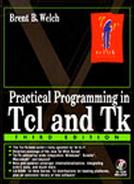Naming Tk Widgets
The period in the name of the button instance, .hello, is required. Tk uses a naming system for the widgets that reflects their position in a hierarchy of widgets. The root of the hierarchy is the main window of the application, and its name is simply a dot (i.e., .). This is similar to the naming convention for directories in UNIX where the root directory is named /, and then / is used to separate components of a file name. Tk uses a dot in the same way. Each widget that is a child of the main window is named something like .foo. A child widget of .foo would be .foo.bar, and so on. Just as file systems have directories that are containers for files and other directories, the Tk window hierarchy uses frame widgets that are containers for widgets and other frames.
Each component of a Tk pathname must start with a lowercase letter or a number. Obviously, a component cannot include a period, either. The lower case restriction avoids a conflict with resource class names that begin with an upper case letter. A resource name can include Tk pathname components and Tk widget classes, and case is used to distinguish them. Chapter 28 describes resources in detail.
 | Store widget names in variables. |
There is one drawback to the Tk widget naming system. If your interface changes enough it can result in some widgets changing their position in the widget hierarchy. In that case they may need to change their name. You can insulate yourself from this programming nuisance by using variables to hold the names of important widgets. Use a variable reference instead of widget pathnames in case you need to change things, or if you want to reuse your code in a different interface.
